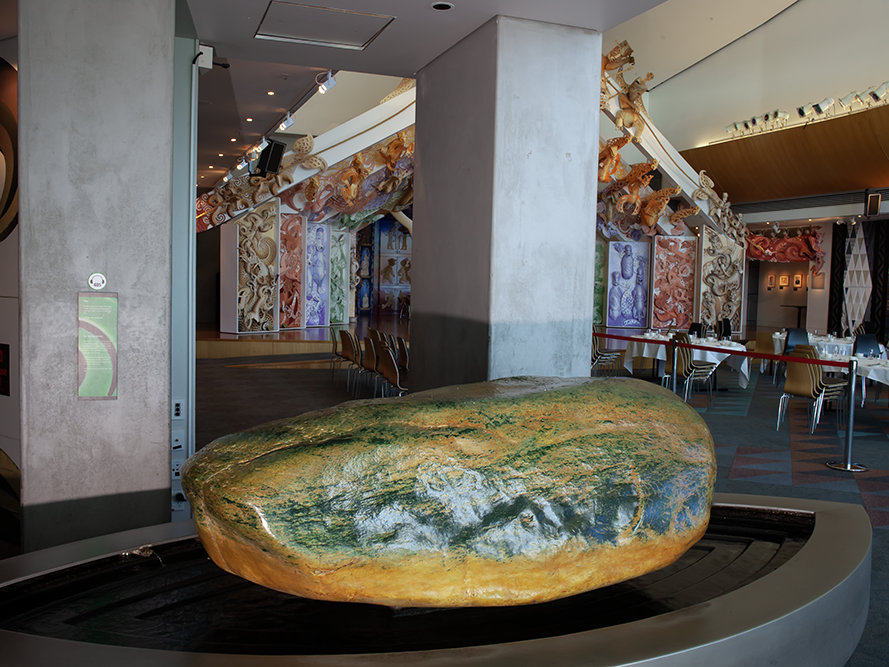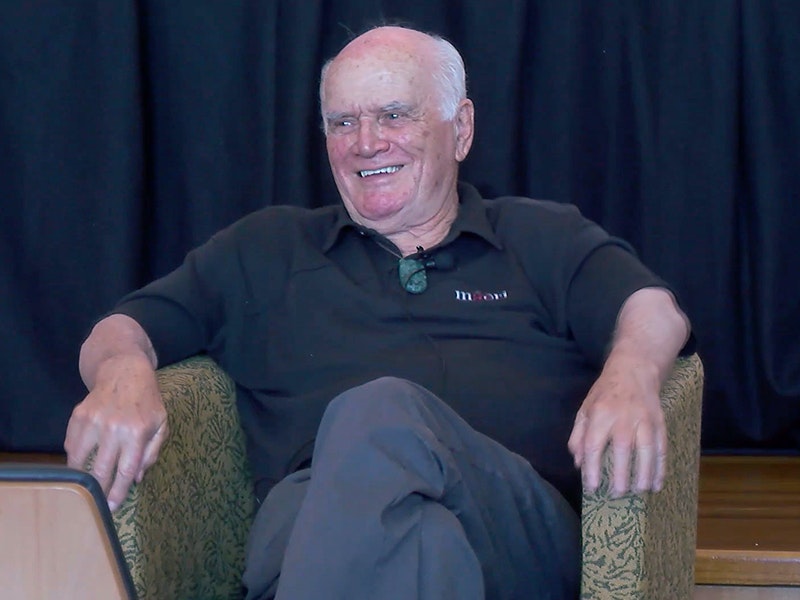The two internal entrances to Rongomaraeroa
Te Tai Ao
This passageway comes in from Mana Whenua gallery space and is accessible during opening hours, unless the marae is in official use and is limited due to safety and cultural reasons.
The Te Tai Ao passageway represents te taiao, as expressed through Māori art and design for Tangata Whenua.
It is the framework of whakapapa and the connection to all things: the sky, the land, the seas, the forest etc. that continue to inform who we are and links us all together on the marae.
Ko au te taiao, te taiao ko au | I am nature, nature is me
Rongomaraeroa, 2015. Photo by Norm Heke. Te Papa (3432)
Te Ara ā Hine – The pathway of women
This is the internal pathway that starts on Level 2 at the heart of the museum and enables direct access to Level 4.
The name of this pathway acknowledges the critical role of wāhine in Māori cosmology, narratives and cultural practices that are fundamental to marae tikanga.
This space is accessible during opening hours unless in use for formal welcomes.
As you move along and up this corridor this space maybe filled with artworks created by the wāhine Māori.
During formal welcomes to the marae this pathway will be filled with the voices of wahine as they call and respond with manuhiri to welcome them to the marae with karanga. So it’s women who guide us along this path to our marae. The artworks in Te Ara ā Hine echo the karanga. They acknowledge women’s role in creation and our links with the natural world. As you move forward and up, you enter into the spirit of the Māori world, at the core of which is the marae.
Jacqueline Fraser, Te Ara a Hine, 1997, Wellington, plastic coated florist and electrical wire. Gift of the Friends of Te Papa, 1997. CC BY-NC-ND 4.0. Te Papa (1997-0047-1/1-6)
External access to Rongomaraeroa
Ngā Kākahu ō Papatūānuku – The cloak of Papatūānuku
The starting point for the external access to Rongomaraeroa is Ngā Kākahu ō Papatūānuku.
Ngā Kākahu ō Papatūānuku is a collective iwi planting area established for the marae in the 90’s and includes rākau gifted from across Aotearoa.
This planting area directly leads to the external stairway, Te Ara a Tāne.
Tāne is the atua of trees, plants and all manner of creatures that cover and look after Papatūānuku.
The iwi contributions from all over Aotearoa are a recognition of the diversity of iwi, hapū, and whānau connection to te taiao and honors the excellence of their mātauranga and histories as tangata whenua.
Ngā Kākahu ō Papatūānuku, 2022. Photo by Daniel Crichton-Rouse. Te Papa (220921)
Te Ara ā Tāne – The pathway of Tāne
This pathway is the external stairs that lead you up to Level 4 where the waharoa, pūwhara and the external marae ātea are located.
This access way is not accessible and reserved for formal occasions only.
The name of this pathway acknowledges the critical male role in Māori creation, narratives and processes that are fundamental to marae tikanga.
The name is also an acknowledgement of Tāne the atua of trees, plants, and all manner of creatures that cover and look after Papatūānuku.
Te Ara ā Tāne, 2022. Photo by Daniel Crichton-Rouse. Te Papa (220918)
Pūwhara – Lookout point
The Pūwhara is the extended platform seen jutting out on Level 4 of the marae towards Te Whanganui-ā-Tara (The great harbour of Tara), Wellington Harbour.
The pūwhara traditionally was located beyond the marae, kāinga, or pā tūwatawata as a strategic vantage point in which to observe and acknowledge approaching manuhiri. From this point would be a sounding call from the use of devices such aspūtātara, or pūkaea to alert the hau kāinga and in turn acknowledge the approaching manuhiri.
Pūwhara of Rongomaraeroa, 2022. Photo by Daniel Crichton-Rouse. Te Papa (220917)
Waharoa – Gateway
The waharoa is the gateway used during pōwhiri only. It is not opened during general opening hours.
The waharoa acts as a meeting point for manuhiri to assemble as a unified rōpu before being called onto the marae ātea by the the hau kāinga.
The waharoa marks the threshold of relationships and the design of this waharoa reflects this kaupapa by acknowledging navigating whakapapa of Tangata Whenua and Tangata Tiriti.
At Te Papa, this signals to manuhiri the shift into our Te Tiriti led context where Māori kawa and tikanga are paramount to the mana of the Rongomaraeroa.
Please note the waharoa is currently deinstalled for repairs.
External entrance to Rongomaraeroa, 2012. Photo by Norman Heke. Te Papa (168500)
Marae ātea (external)
by artist Kura Te Waru Rewiri (Ngāti Kahu, Ngapuhi)
The marae ātea has internal and external components – it is the pattern ground that sits directly in front of the wharenui, Te Hono ki Hawaiki, and extends to the waharoa.
During formal events such as pōwhiri the Ranginui doors are opened which enables an uninterrupted marae ātea space.
The design of the external tiles and internal carpet patterns were created by artist Kura Te Waru Rewiri These designs honor raranga traditions and represent Papatūānuku. This ātea space is appropriately linked with the Ranginui doors, as they embody the primordial atua of Māori cosmology.
Marae ātea, Rongomaraeroa, 2022. Photo by Daniel Crichton-Rouse. Te Papa (220920)
Ngāti Toa Rangatira pou whakairo
by artist Hermann Salzmann (Ngāti Toa Rangatira)
This pou whakairo on the marae ātea was created by Herman Salzmann and was created and installed to mark the closing of the Ngāti Toa Rangatira Iwi exhibition Whiti te Rā.
The pou Whakairo also acknowledges Ngāti Toa Rangatira are mana whenua within Te Upoko-o-te-ika-a-Māui, the Wellington region.
Ngāti Toa Rangatira pou whakairo on Rongomaraeroa, 2022. Photo by Daniel Crichton-Rouse. Te Papa (220916)
Te Ngutu Wairua – Spiritual doorway
by artists Rangi Kipa, Darcy Nicholas, and Wi Taepa
Te Ngutu Wairua is a kūwaha that enables access between the internal and external areas of Rongomaraeroa. This is accessible during standard museum opening hours.
This entranceway Te Ngutu Wairua comprises of three artworks by Rangi Kipa, Darcy Nicholas, and Wi Taepa who are all of Te Ātiawa descent.
Te Ngutu Wairua honours the special relationship between Te Papa and the establishment of a national marae and museum on the whenua of Te Āti Awa. Each artist worked with the idea of Te Atiawatangawithin their chosen art forms.
The carved entranceway was created by artist Rangi Kipa to represents te taiao of Te Āti Awa.
Inside the doorway are the etched drawings by Darcy Nicholas depicting the tūpuna Rongouera, Heketanga-a-Rangi, and Awanui-a-Rangi.
Flanking the entrance way on the internal ātea of the marae are ngā uku representing korere and hoe created by Wi Taepa.
Te Ngutu Wairua entranceway. Photo by Te Papa
Te Kōhatu Mauri o Rongomaraeroa
The large pounamu boulder is the kōhatu mauri for the marae, it symbolises the enduring energy or essence of the marae.
It is a solid, tangible and permanent foundation of Rongomaraeroa and all that the marae represents to all peoples of Aotearoa New Zealand.
This particular kōhatu was gifted to the museum by Ngāi Tahu in 1987 and was lifted out of the Arahura River on the West Coast of the South Island.
Visitors are invited to connect through the act of rubbing stone and water over kōhatu as an acknowledgement and care of the values of Rongomaraeroa.
Kōhatu Mauri, 2012. Photo by Norman Heke. Te Papa (168499)
Ranginui door – ceremonial entranceway
By Robert Jahnke (Te Whānau a Rākairoa and Ngāti Porou)
The stained-glass doors found on the marae ātea are called the Ranginui doors. It is the grand entrance to the internal marae ātea and the wharenui, and is reserved for powhiri and other formal occasions of welcome.
The stain glass elements created by artist Robert Jahnke represent Ranginui.
When activated, the door opens upwards to enact light to stream in and an uninterrupted entrance way between the waharoa and wharenui.
The moment of opening the doors where Ranginui is separated form Papatūānuku is a conceptual enactment of Te Wehenga which is a pivotal moment in Māori cosmology and whakapapa. This action and moment of pushing apart creates the space between where we all live today, known as Te Ao Mārama.
Ranguinui door of Rongomaraeroa, 2022. Photo by Jane Harris. Te Papa
Marae ātea (internal)
By artist Kura Te Waru Rewiri (Ngāti Kahu, Ngāpuhi)
The internal marae ātea is a meeting place for hau kāinga and manuhiri. This area is under shelter in front of the wharenui Te Hono ki Hawaiki. It is accessible during opening hours unless in use for formal occasions.
On formal occasions such as pōwhiri or whakatau the ātea space is the formal meeting space where Māori tikanga and kawa are paramount. It is a space of whaikōrero and debate, waiata and expressions of the māori arts of whanaungatanga, relationship, connection, debate, and rangatiratanga.
The design of the external tiles and internal carpet patterns by artist Kura Te Waru Rewiri honour raranga traditions and represent Papatūānuku and this ātea space is appropriately linked with the Ranginui doors, who embody the primordial atua of Māori cosmology and whakapapa.
The wharenui – Te Hono ki Hawaiki
The wharenui is the focal point for the stories and relationships of all people who come onto the marae.
Find out about the different parts of Te Hono ki Hawaiki.
Te Hono ki Hawaiki, Rongomaraeroa. Photo by Jane Harris. Te Papa


